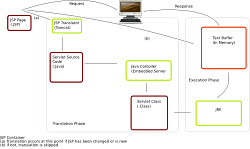
The Java Servlet API is a software that allows developer to add dynamic content to a Web server using the Java platform. The generated content is mostly HTML, but may beother data such as XML. Servlets are the Java counterpart to non-Java dynamic Web content technologies such as PHP, CGI and ASP.NET. Servlets can maintain state across many server transactions by using HTTP cookies, session variables or URL rewriting.
The Servlet API, contained in the Java package hierarchy javax.servlet, defines the expected interactions of a Web container and a servlet. A Web container is essentially the component of a Web server that interacts with the servlets. The Web container is responsible for managing the lifecycle of servlets, mapping a URL to a particular servlet and ensures that the URL requester has the correct access rights.
A Servlet is an object that receives a request and generates a response based on that request. The basic servlet package defines Java objects to represent servlet requests and responses, as well as objects to reflect the servlet's configuration parameters and execution environment. The package javax.servlet.http defines HTTP-specific subclasses of the generic servlet elements, including session management objects that track multiple requests and responses between the Web server and a client. Servlets may be packaged in a WAR file as a Web application.
No comments:
Post a Comment